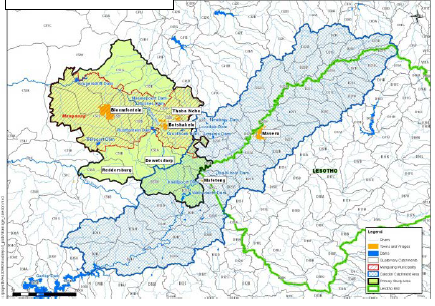|
|
The Greater Bloemfontein Supply System provides the majority of potable water
requirements to Bloemfontein, Thaba Nchu, Botshabelo, Wepener, Dewetsdorp,
Reddersburg, Edenburg, and Excelsior. Agricultural water requirements in the
Modder-Riet catchment upstream of Krugersdrift Dam and along the Caledon River
were also taken into consideration, as these water requirements may impact on
the reconciliation of supply and requirement. The majority of the Greater
Bloemfontein supply system is located within the Mangaung Metropolitan
Municipality, which falls within the Motheo District Municipality. As such, the
boundary of the Primary Study Area was defined by the municipal boundary of MMM.
The Secondary Study Area is defined by the Caledon River, which is the main
river system providing surface water to Bloem Water.
|

Study Area for the Greater Bloemfontein Water Supply System |
The main storage dams of the Greater Bloemfontein Supply System are the
Welbedacht, Knellpoort off-channel storage, Krugersdrift, Mockes, and
Rustfontein dams. Bloem Water is the main supplier of bulk potable water to
urban centres in the Modder / Riet sub-catchment. The other water service
provider is MMM which supplies about 25% of Bloemfontein’s water requirements
via the Maselspoort Scheme. The primary source of water is the Caledon and
Orange rivers. As both of these river systems are a great distance from the
water demand centres, several transfer schemes have been developed. The main
transfer water supply schemes are: (1) the Caledon – Bloemfontein transfer which
supplies Bloemfontein, Dewetsdorp, and small users from Welbedacht Dam, (2) the
Maselspoort Scheme, and (3) the Caledon – Modder (also known as the Novo
Transfer Scheme) which supplies water via the Rustfontein Treatment Works to
Bloemfontein, Botshabelo, and Thaba Nchu.
Population
The 2010 population in the Bloemfontein, Botshableo and Thaba Nchu area of supply
is estimated to be 630 000 people. The population for the full supply area
including the smaller towns is estimated to be 720 000 people. In order to
estimate the future bulk water requirements, two population growth rates were
developed. The high growth scenario is based on the IDP Report (2007/2008) which
indicated that the future population growth rate for MMM will be 3.2% per annum.
The low population growth scenario is based on the report entitled
“Identification of Bulk Engineering Infrastructure in Support of Housing
Development in Mangaung” which is a masterplan prepared for Mangaung
Metropolitan Municipality determined that the anticipated population growth
figures for Bloemfontein up to 2030 would be 1% per annum.
Economic Activities
Bloemfontein has been the focus of development in recent years which has resulted
in the centralisation of services to Bloemfontein and also an increase in
population.
Another development trend that is evident in all of the urban nodes of Motheo
District Municipality is the increase in immigration to these small towns. This
can primarily be attributed to farm workers leaving the farm to settle in town
as a result of labour dispute or farmers having had to reduce the number of
employees on the farm due to a decline in the agricultural sector. There is thus
an increase in the number of informal settlements in these towns with
Bloemfontein in particular experiencing high levels of influx (Motheo IDP,
2003). |